Business Operations Report: Accounting, Teams, and Motivation
VerifiedAdded on 2022/12/23
|14
|3668
|83
Report
AI Summary
This report provides a comprehensive overview of business operations, encompassing various aspects of the business environment. It begins by differentiating between private and public sector organizations, providing examples and examining organizational structures within a selected country. The report then delves into the impact of the local, national, and global economic environments on businesses, utilizing PESTLE analysis to assess external factors. Key business functions are then explored, including the importance of accounting for business success and the roles of the HR department. The report also examines employment legislation and presents key accounting information using profit and loss accounts. Furthermore, the report analyzes team development stages, explores team roles, and assesses three motivation theories. Finally, it discusses different leadership styles and the impact of customer service on business success, including the benefits of customer profiling. The report provides a holistic understanding of business operations and management.
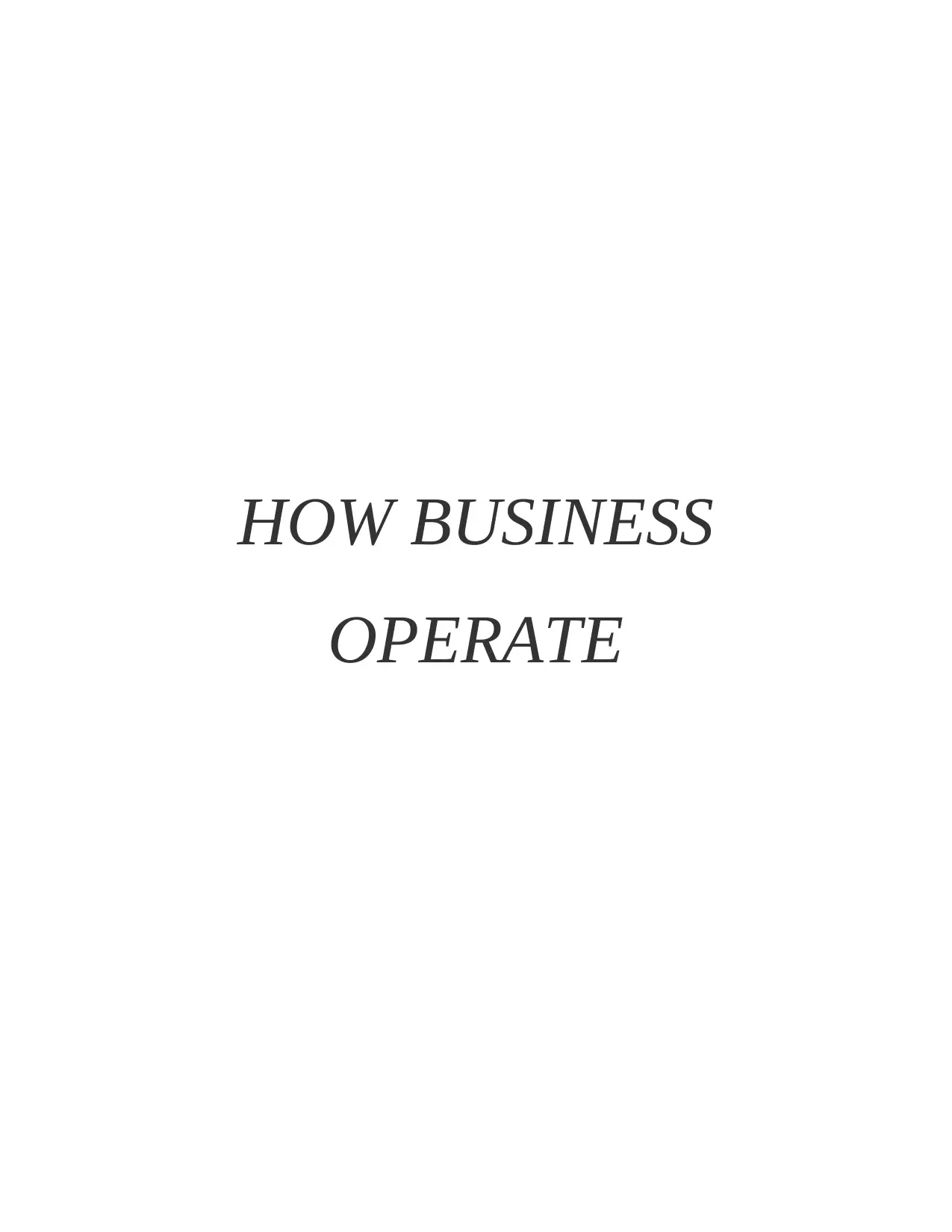
HOW BUSINESS
OPERATE
OPERATE
Paraphrase This Document
Need a fresh take? Get an instant paraphrase of this document with our AI Paraphraser
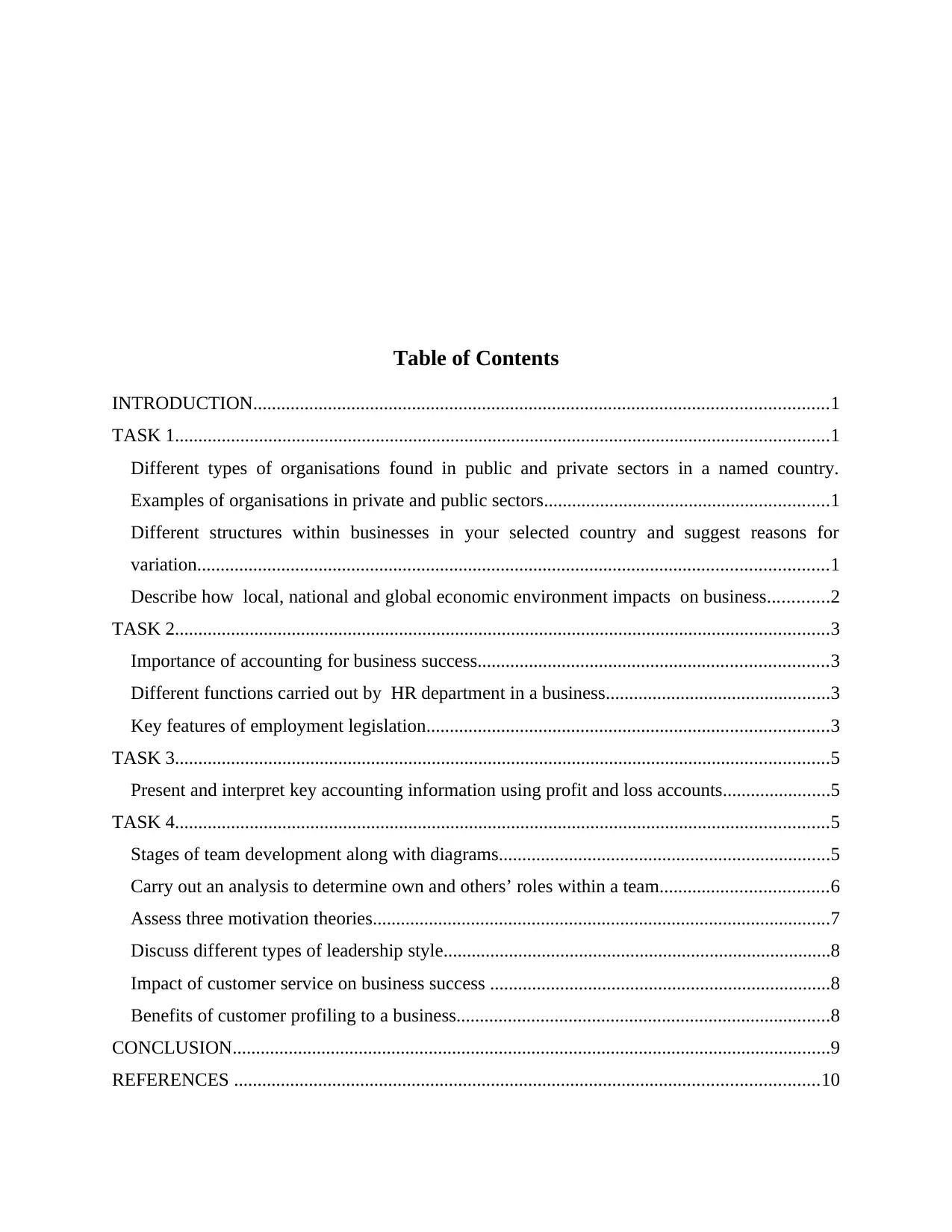
Table of Contents
INTRODUCTION...........................................................................................................................1
TASK 1............................................................................................................................................1
Different types of organisations found in public and private sectors in a named country.
Examples of organisations in private and public sectors.............................................................1
Different structures within businesses in your selected country and suggest reasons for
variation.......................................................................................................................................1
Describe how local, national and global economic environment impacts on business.............2
TASK 2............................................................................................................................................3
Importance of accounting for business success...........................................................................3
Different functions carried out by HR department in a business................................................3
Key features of employment legislation......................................................................................3
TASK 3............................................................................................................................................5
Present and interpret key accounting information using profit and loss accounts.......................5
TASK 4............................................................................................................................................5
Stages of team development along with diagrams.......................................................................5
Carry out an analysis to determine own and others’ roles within a team....................................6
Assess three motivation theories..................................................................................................7
Discuss different types of leadership style...................................................................................8
Impact of customer service on business success .........................................................................8
Benefits of customer profiling to a business................................................................................8
CONCLUSION................................................................................................................................9
REFERENCES .............................................................................................................................10
INTRODUCTION...........................................................................................................................1
TASK 1............................................................................................................................................1
Different types of organisations found in public and private sectors in a named country.
Examples of organisations in private and public sectors.............................................................1
Different structures within businesses in your selected country and suggest reasons for
variation.......................................................................................................................................1
Describe how local, national and global economic environment impacts on business.............2
TASK 2............................................................................................................................................3
Importance of accounting for business success...........................................................................3
Different functions carried out by HR department in a business................................................3
Key features of employment legislation......................................................................................3
TASK 3............................................................................................................................................5
Present and interpret key accounting information using profit and loss accounts.......................5
TASK 4............................................................................................................................................5
Stages of team development along with diagrams.......................................................................5
Carry out an analysis to determine own and others’ roles within a team....................................6
Assess three motivation theories..................................................................................................7
Discuss different types of leadership style...................................................................................8
Impact of customer service on business success .........................................................................8
Benefits of customer profiling to a business................................................................................8
CONCLUSION................................................................................................................................9
REFERENCES .............................................................................................................................10
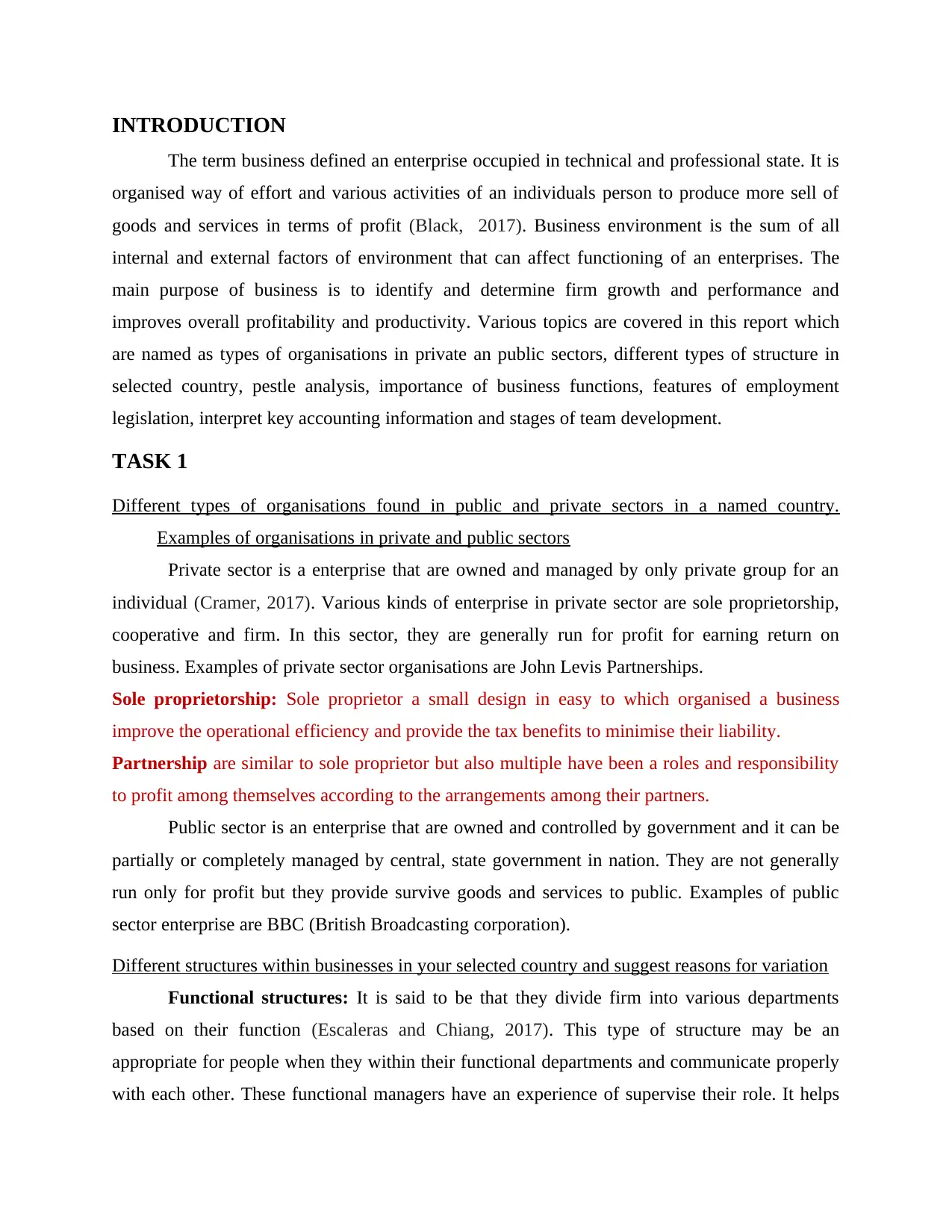
INTRODUCTION
The term business defined an enterprise occupied in technical and professional state. It is
organised way of effort and various activities of an individuals person to produce more sell of
goods and services in terms of profit (Black, 2017). Business environment is the sum of all
internal and external factors of environment that can affect functioning of an enterprises. The
main purpose of business is to identify and determine firm growth and performance and
improves overall profitability and productivity. Various topics are covered in this report which
are named as types of organisations in private an public sectors, different types of structure in
selected country, pestle analysis, importance of business functions, features of employment
legislation, interpret key accounting information and stages of team development.
TASK 1
Different types of organisations found in public and private sectors in a named country.
Examples of organisations in private and public sectors
Private sector is a enterprise that are owned and managed by only private group for an
individual (Cramer, 2017). Various kinds of enterprise in private sector are sole proprietorship,
cooperative and firm. In this sector, they are generally run for profit for earning return on
business. Examples of private sector organisations are John Levis Partnerships.
Sole proprietorship: Sole proprietor a small design in easy to which organised a business
improve the operational efficiency and provide the tax benefits to minimise their liability.
Partnership are similar to sole proprietor but also multiple have been a roles and responsibility
to profit among themselves according to the arrangements among their partners.
Public sector is an enterprise that are owned and controlled by government and it can be
partially or completely managed by central, state government in nation. They are not generally
run only for profit but they provide survive goods and services to public. Examples of public
sector enterprise are BBC (British Broadcasting corporation).
Different structures within businesses in your selected country and suggest reasons for variation
Functional structures: It is said to be that they divide firm into various departments
based on their function (Escaleras and Chiang, 2017). This type of structure may be an
appropriate for people when they within their functional departments and communicate properly
with each other. These functional managers have an experience of supervise their role. It helps
The term business defined an enterprise occupied in technical and professional state. It is
organised way of effort and various activities of an individuals person to produce more sell of
goods and services in terms of profit (Black, 2017). Business environment is the sum of all
internal and external factors of environment that can affect functioning of an enterprises. The
main purpose of business is to identify and determine firm growth and performance and
improves overall profitability and productivity. Various topics are covered in this report which
are named as types of organisations in private an public sectors, different types of structure in
selected country, pestle analysis, importance of business functions, features of employment
legislation, interpret key accounting information and stages of team development.
TASK 1
Different types of organisations found in public and private sectors in a named country.
Examples of organisations in private and public sectors
Private sector is a enterprise that are owned and managed by only private group for an
individual (Cramer, 2017). Various kinds of enterprise in private sector are sole proprietorship,
cooperative and firm. In this sector, they are generally run for profit for earning return on
business. Examples of private sector organisations are John Levis Partnerships.
Sole proprietorship: Sole proprietor a small design in easy to which organised a business
improve the operational efficiency and provide the tax benefits to minimise their liability.
Partnership are similar to sole proprietor but also multiple have been a roles and responsibility
to profit among themselves according to the arrangements among their partners.
Public sector is an enterprise that are owned and controlled by government and it can be
partially or completely managed by central, state government in nation. They are not generally
run only for profit but they provide survive goods and services to public. Examples of public
sector enterprise are BBC (British Broadcasting corporation).
Different structures within businesses in your selected country and suggest reasons for variation
Functional structures: It is said to be that they divide firm into various departments
based on their function (Escaleras and Chiang, 2017). This type of structure may be an
appropriate for people when they within their functional departments and communicate properly
with each other. These functional managers have an experience of supervise their role. It helps
⊘ This is a preview!⊘
Do you want full access?
Subscribe today to unlock all pages.

Trusted by 1+ million students worldwide
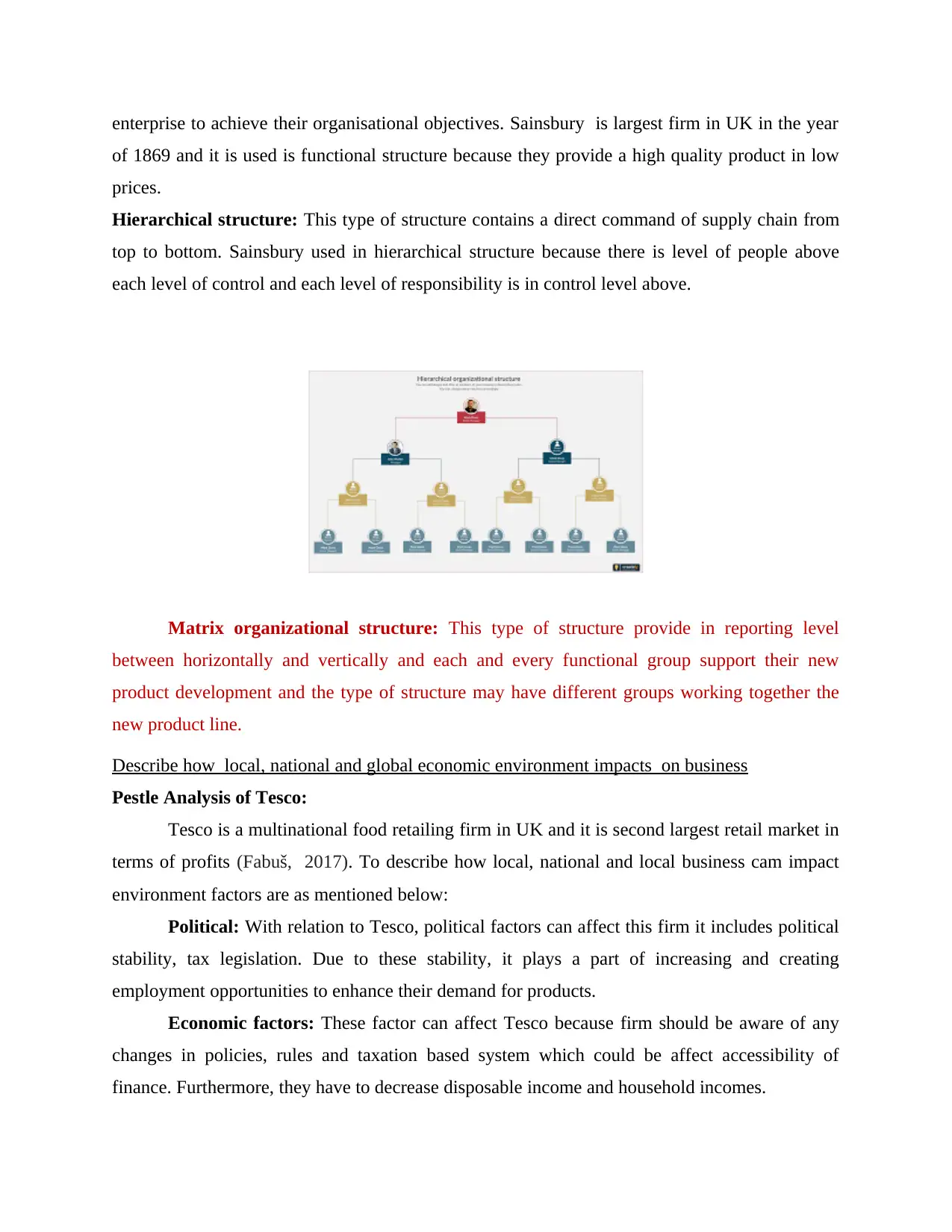
enterprise to achieve their organisational objectives. Sainsbury is largest firm in UK in the year
of 1869 and it is used is functional structure because they provide a high quality product in low
prices.
Hierarchical structure: This type of structure contains a direct command of supply chain from
top to bottom. Sainsbury used in hierarchical structure because there is level of people above
each level of control and each level of responsibility is in control level above.
Matrix organizational structure: This type of structure provide in reporting level
between horizontally and vertically and each and every functional group support their new
product development and the type of structure may have different groups working together the
new product line.
Describe how local, national and global economic environment impacts on business
Pestle Analysis of Tesco:
Tesco is a multinational food retailing firm in UK and it is second largest retail market in
terms of profits (Fabuš, 2017). To describe how local, national and local business cam impact
environment factors are as mentioned below:
Political: With relation to Tesco, political factors can affect this firm it includes political
stability, tax legislation. Due to these stability, it plays a part of increasing and creating
employment opportunities to enhance their demand for products.
Economic factors: These factor can affect Tesco because firm should be aware of any
changes in policies, rules and taxation based system which could be affect accessibility of
finance. Furthermore, they have to decrease disposable income and household incomes.
of 1869 and it is used is functional structure because they provide a high quality product in low
prices.
Hierarchical structure: This type of structure contains a direct command of supply chain from
top to bottom. Sainsbury used in hierarchical structure because there is level of people above
each level of control and each level of responsibility is in control level above.
Matrix organizational structure: This type of structure provide in reporting level
between horizontally and vertically and each and every functional group support their new
product development and the type of structure may have different groups working together the
new product line.
Describe how local, national and global economic environment impacts on business
Pestle Analysis of Tesco:
Tesco is a multinational food retailing firm in UK and it is second largest retail market in
terms of profits (Fabuš, 2017). To describe how local, national and local business cam impact
environment factors are as mentioned below:
Political: With relation to Tesco, political factors can affect this firm it includes political
stability, tax legislation. Due to these stability, it plays a part of increasing and creating
employment opportunities to enhance their demand for products.
Economic factors: These factor can affect Tesco because firm should be aware of any
changes in policies, rules and taxation based system which could be affect accessibility of
finance. Furthermore, they have to decrease disposable income and household incomes.
Paraphrase This Document
Need a fresh take? Get an instant paraphrase of this document with our AI Paraphraser
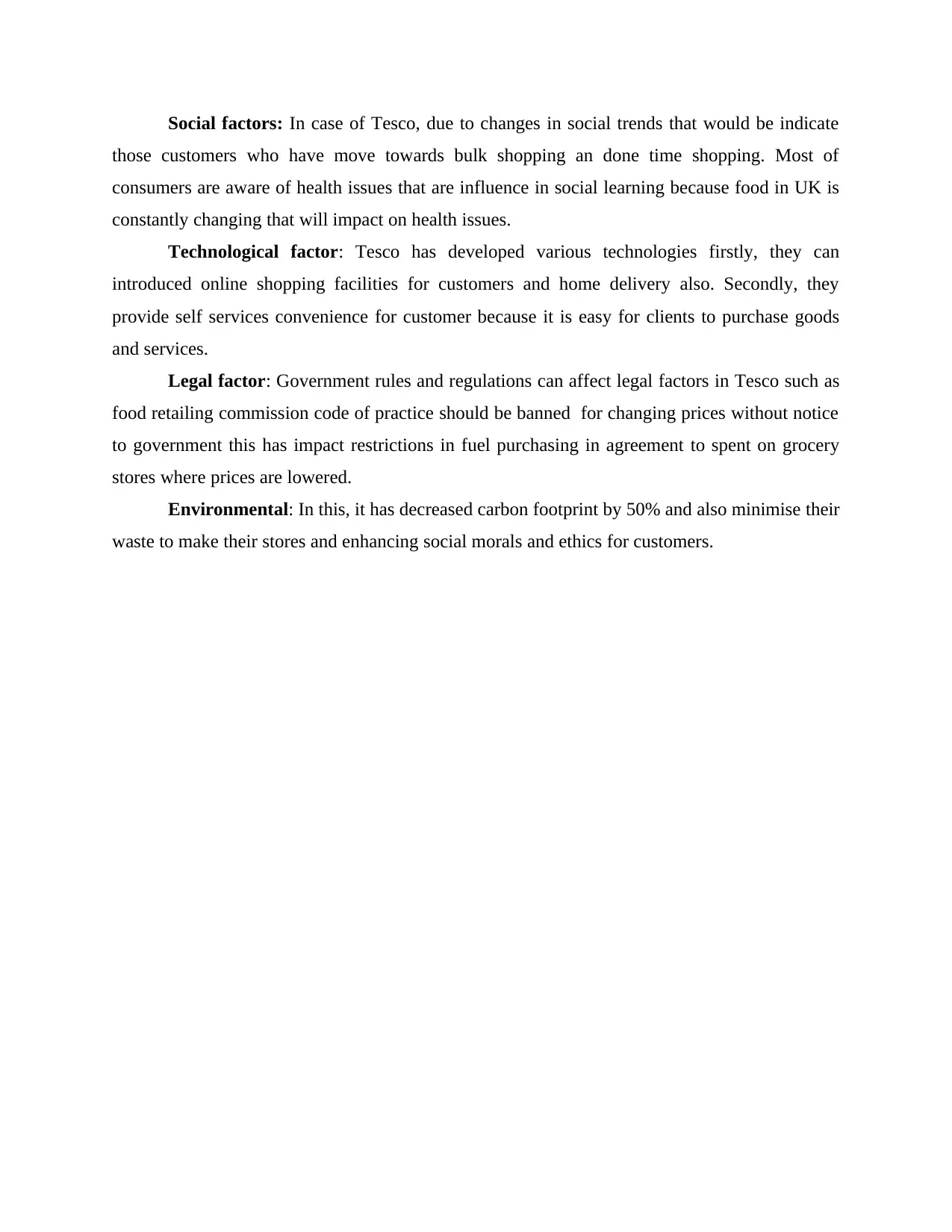
Social factors: In case of Tesco, due to changes in social trends that would be indicate
those customers who have move towards bulk shopping an done time shopping. Most of
consumers are aware of health issues that are influence in social learning because food in UK is
constantly changing that will impact on health issues.
Technological factor: Tesco has developed various technologies firstly, they can
introduced online shopping facilities for customers and home delivery also. Secondly, they
provide self services convenience for customer because it is easy for clients to purchase goods
and services.
Legal factor: Government rules and regulations can affect legal factors in Tesco such as
food retailing commission code of practice should be banned for changing prices without notice
to government this has impact restrictions in fuel purchasing in agreement to spent on grocery
stores where prices are lowered.
Environmental: In this, it has decreased carbon footprint by 50% and also minimise their
waste to make their stores and enhancing social morals and ethics for customers.
those customers who have move towards bulk shopping an done time shopping. Most of
consumers are aware of health issues that are influence in social learning because food in UK is
constantly changing that will impact on health issues.
Technological factor: Tesco has developed various technologies firstly, they can
introduced online shopping facilities for customers and home delivery also. Secondly, they
provide self services convenience for customer because it is easy for clients to purchase goods
and services.
Legal factor: Government rules and regulations can affect legal factors in Tesco such as
food retailing commission code of practice should be banned for changing prices without notice
to government this has impact restrictions in fuel purchasing in agreement to spent on grocery
stores where prices are lowered.
Environmental: In this, it has decreased carbon footprint by 50% and also minimise their
waste to make their stores and enhancing social morals and ethics for customers.
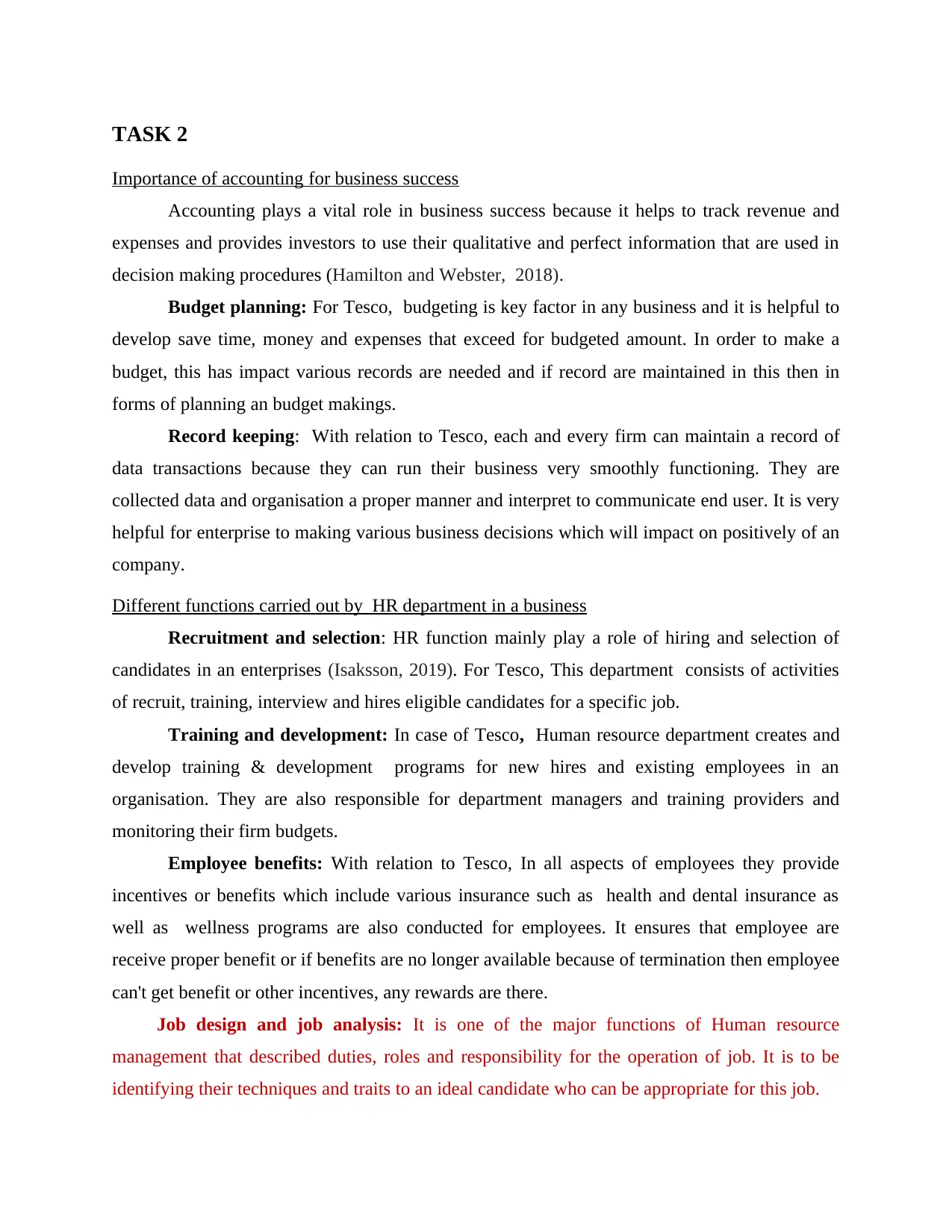
TASK 2
Importance of accounting for business success
Accounting plays a vital role in business success because it helps to track revenue and
expenses and provides investors to use their qualitative and perfect information that are used in
decision making procedures (Hamilton and Webster, 2018).
Budget planning: For Tesco, budgeting is key factor in any business and it is helpful to
develop save time, money and expenses that exceed for budgeted amount. In order to make a
budget, this has impact various records are needed and if record are maintained in this then in
forms of planning an budget makings.
Record keeping: With relation to Tesco, each and every firm can maintain a record of
data transactions because they can run their business very smoothly functioning. They are
collected data and organisation a proper manner and interpret to communicate end user. It is very
helpful for enterprise to making various business decisions which will impact on positively of an
company.
Different functions carried out by HR department in a business
Recruitment and selection: HR function mainly play a role of hiring and selection of
candidates in an enterprises (Isaksson, 2019). For Tesco, This department consists of activities
of recruit, training, interview and hires eligible candidates for a specific job.
Training and development: In case of Tesco, Human resource department creates and
develop training & development programs for new hires and existing employees in an
organisation. They are also responsible for department managers and training providers and
monitoring their firm budgets.
Employee benefits: With relation to Tesco, In all aspects of employees they provide
incentives or benefits which include various insurance such as health and dental insurance as
well as wellness programs are also conducted for employees. It ensures that employee are
receive proper benefit or if benefits are no longer available because of termination then employee
can't get benefit or other incentives, any rewards are there.
Job design and job analysis: It is one of the major functions of Human resource
management that described duties, roles and responsibility for the operation of job. It is to be
identifying their techniques and traits to an ideal candidate who can be appropriate for this job.
Importance of accounting for business success
Accounting plays a vital role in business success because it helps to track revenue and
expenses and provides investors to use their qualitative and perfect information that are used in
decision making procedures (Hamilton and Webster, 2018).
Budget planning: For Tesco, budgeting is key factor in any business and it is helpful to
develop save time, money and expenses that exceed for budgeted amount. In order to make a
budget, this has impact various records are needed and if record are maintained in this then in
forms of planning an budget makings.
Record keeping: With relation to Tesco, each and every firm can maintain a record of
data transactions because they can run their business very smoothly functioning. They are
collected data and organisation a proper manner and interpret to communicate end user. It is very
helpful for enterprise to making various business decisions which will impact on positively of an
company.
Different functions carried out by HR department in a business
Recruitment and selection: HR function mainly play a role of hiring and selection of
candidates in an enterprises (Isaksson, 2019). For Tesco, This department consists of activities
of recruit, training, interview and hires eligible candidates for a specific job.
Training and development: In case of Tesco, Human resource department creates and
develop training & development programs for new hires and existing employees in an
organisation. They are also responsible for department managers and training providers and
monitoring their firm budgets.
Employee benefits: With relation to Tesco, In all aspects of employees they provide
incentives or benefits which include various insurance such as health and dental insurance as
well as wellness programs are also conducted for employees. It ensures that employee are
receive proper benefit or if benefits are no longer available because of termination then employee
can't get benefit or other incentives, any rewards are there.
Job design and job analysis: It is one of the major functions of Human resource
management that described duties, roles and responsibility for the operation of job. It is to be
identifying their techniques and traits to an ideal candidate who can be appropriate for this job.
⊘ This is a preview!⊘
Do you want full access?
Subscribe today to unlock all pages.

Trusted by 1+ million students worldwide
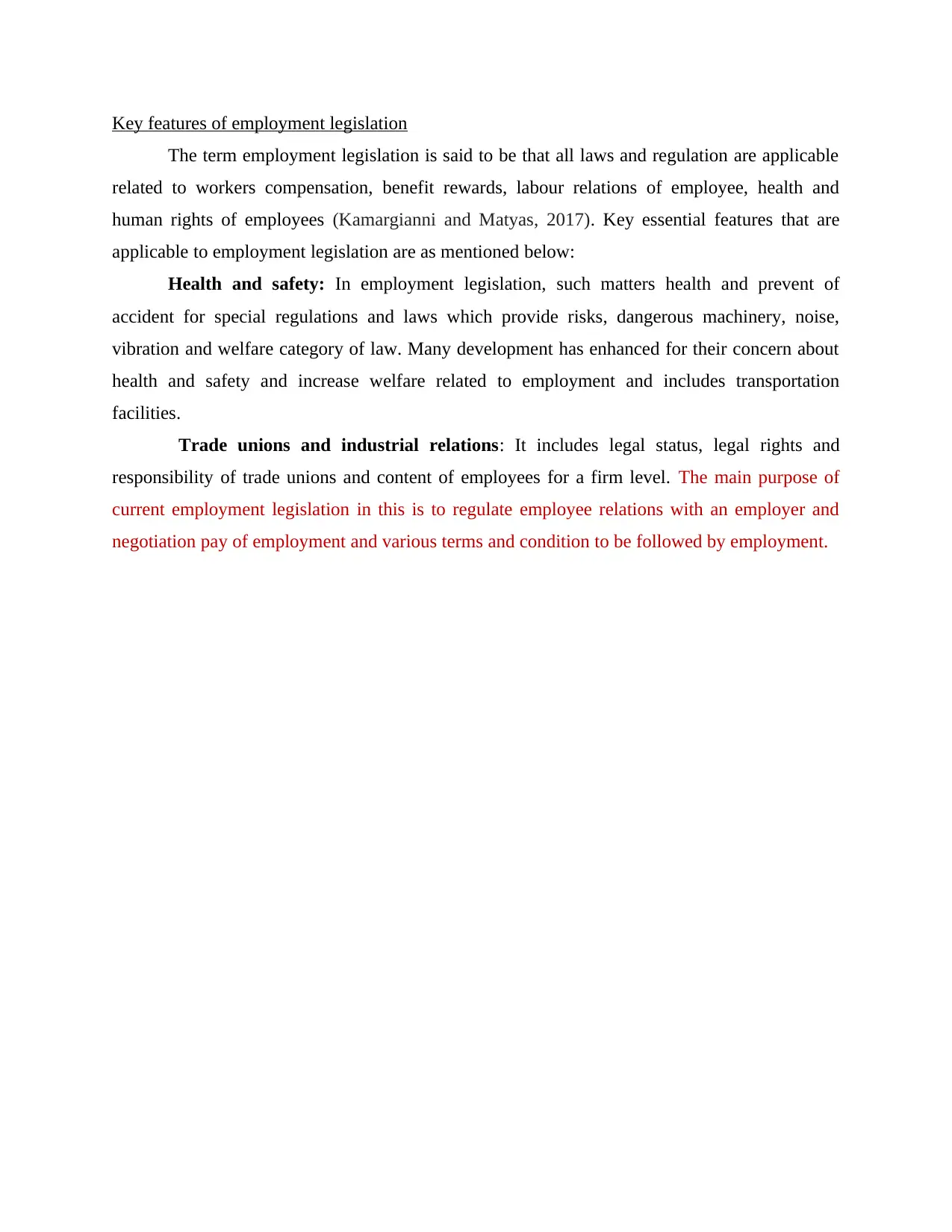
Key features of employment legislation
The term employment legislation is said to be that all laws and regulation are applicable
related to workers compensation, benefit rewards, labour relations of employee, health and
human rights of employees (Kamargianni and Matyas, 2017). Key essential features that are
applicable to employment legislation are as mentioned below:
Health and safety: In employment legislation, such matters health and prevent of
accident for special regulations and laws which provide risks, dangerous machinery, noise,
vibration and welfare category of law. Many development has enhanced for their concern about
health and safety and increase welfare related to employment and includes transportation
facilities.
Trade unions and industrial relations: It includes legal status, legal rights and
responsibility of trade unions and content of employees for a firm level. The main purpose of
current employment legislation in this is to regulate employee relations with an employer and
negotiation pay of employment and various terms and condition to be followed by employment.
The term employment legislation is said to be that all laws and regulation are applicable
related to workers compensation, benefit rewards, labour relations of employee, health and
human rights of employees (Kamargianni and Matyas, 2017). Key essential features that are
applicable to employment legislation are as mentioned below:
Health and safety: In employment legislation, such matters health and prevent of
accident for special regulations and laws which provide risks, dangerous machinery, noise,
vibration and welfare category of law. Many development has enhanced for their concern about
health and safety and increase welfare related to employment and includes transportation
facilities.
Trade unions and industrial relations: It includes legal status, legal rights and
responsibility of trade unions and content of employees for a firm level. The main purpose of
current employment legislation in this is to regulate employee relations with an employer and
negotiation pay of employment and various terms and condition to be followed by employment.
Paraphrase This Document
Need a fresh take? Get an instant paraphrase of this document with our AI Paraphraser
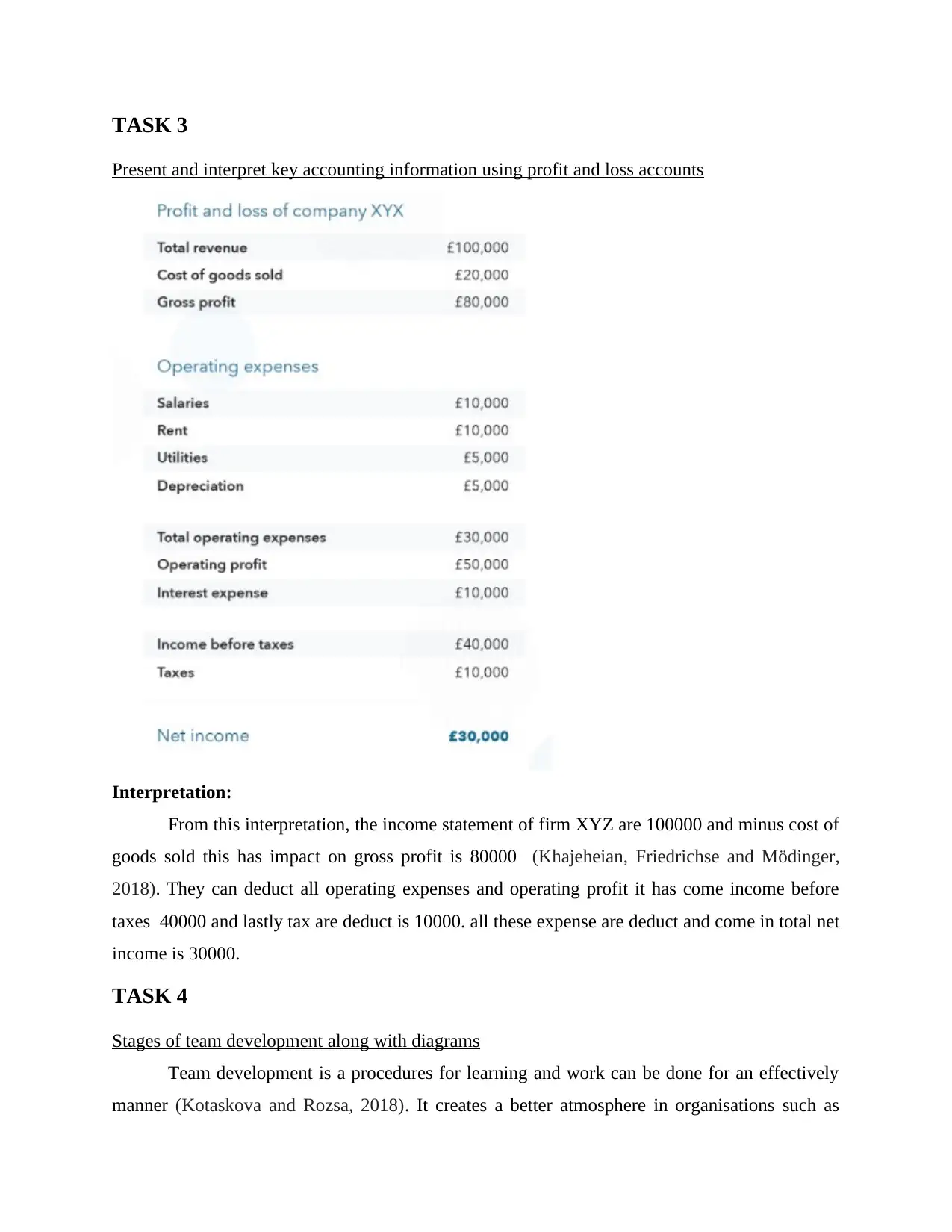
TASK 3
Present and interpret key accounting information using profit and loss accounts
Interpretation:
From this interpretation, the income statement of firm XYZ are 100000 and minus cost of
goods sold this has impact on gross profit is 80000 (Khajeheian, Friedrichse and Mödinger,
2018). They can deduct all operating expenses and operating profit it has come income before
taxes 40000 and lastly tax are deduct is 10000. all these expense are deduct and come in total net
income is 30000.
TASK 4
Stages of team development along with diagrams
Team development is a procedures for learning and work can be done for an effectively
manner (Kotaskova and Rozsa, 2018). It creates a better atmosphere in organisations such as
Present and interpret key accounting information using profit and loss accounts
Interpretation:
From this interpretation, the income statement of firm XYZ are 100000 and minus cost of
goods sold this has impact on gross profit is 80000 (Khajeheian, Friedrichse and Mödinger,
2018). They can deduct all operating expenses and operating profit it has come income before
taxes 40000 and lastly tax are deduct is 10000. all these expense are deduct and come in total net
income is 30000.
TASK 4
Stages of team development along with diagrams
Team development is a procedures for learning and work can be done for an effectively
manner (Kotaskova and Rozsa, 2018). It creates a better atmosphere in organisations such as
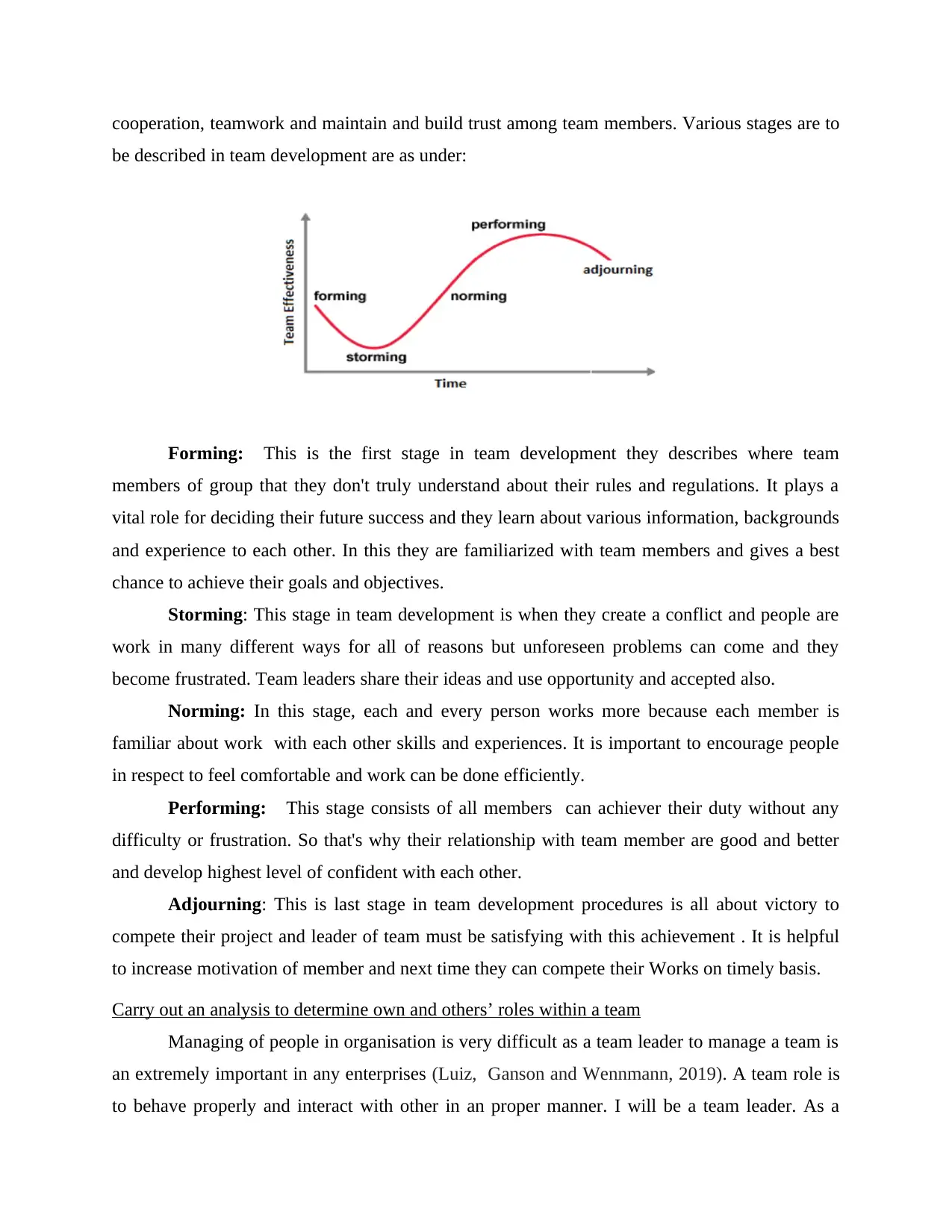
cooperation, teamwork and maintain and build trust among team members. Various stages are to
be described in team development are as under:
Forming: This is the first stage in team development they describes where team
members of group that they don't truly understand about their rules and regulations. It plays a
vital role for deciding their future success and they learn about various information, backgrounds
and experience to each other. In this they are familiarized with team members and gives a best
chance to achieve their goals and objectives.
Storming: This stage in team development is when they create a conflict and people are
work in many different ways for all of reasons but unforeseen problems can come and they
become frustrated. Team leaders share their ideas and use opportunity and accepted also.
Norming: In this stage, each and every person works more because each member is
familiar about work with each other skills and experiences. It is important to encourage people
in respect to feel comfortable and work can be done efficiently.
Performing: This stage consists of all members can achiever their duty without any
difficulty or frustration. So that's why their relationship with team member are good and better
and develop highest level of confident with each other.
Adjourning: This is last stage in team development procedures is all about victory to
compete their project and leader of team must be satisfying with this achievement . It is helpful
to increase motivation of member and next time they can compete their Works on timely basis.
Carry out an analysis to determine own and others’ roles within a team
Managing of people in organisation is very difficult as a team leader to manage a team is
an extremely important in any enterprises (Luiz, Ganson and Wennmann, 2019). A team role is
to behave properly and interact with other in an proper manner. I will be a team leader. As a
be described in team development are as under:
Forming: This is the first stage in team development they describes where team
members of group that they don't truly understand about their rules and regulations. It plays a
vital role for deciding their future success and they learn about various information, backgrounds
and experience to each other. In this they are familiarized with team members and gives a best
chance to achieve their goals and objectives.
Storming: This stage in team development is when they create a conflict and people are
work in many different ways for all of reasons but unforeseen problems can come and they
become frustrated. Team leaders share their ideas and use opportunity and accepted also.
Norming: In this stage, each and every person works more because each member is
familiar about work with each other skills and experiences. It is important to encourage people
in respect to feel comfortable and work can be done efficiently.
Performing: This stage consists of all members can achiever their duty without any
difficulty or frustration. So that's why their relationship with team member are good and better
and develop highest level of confident with each other.
Adjourning: This is last stage in team development procedures is all about victory to
compete their project and leader of team must be satisfying with this achievement . It is helpful
to increase motivation of member and next time they can compete their Works on timely basis.
Carry out an analysis to determine own and others’ roles within a team
Managing of people in organisation is very difficult as a team leader to manage a team is
an extremely important in any enterprises (Luiz, Ganson and Wennmann, 2019). A team role is
to behave properly and interact with other in an proper manner. I will be a team leader. As a
⊘ This is a preview!⊘
Do you want full access?
Subscribe today to unlock all pages.

Trusted by 1+ million students worldwide
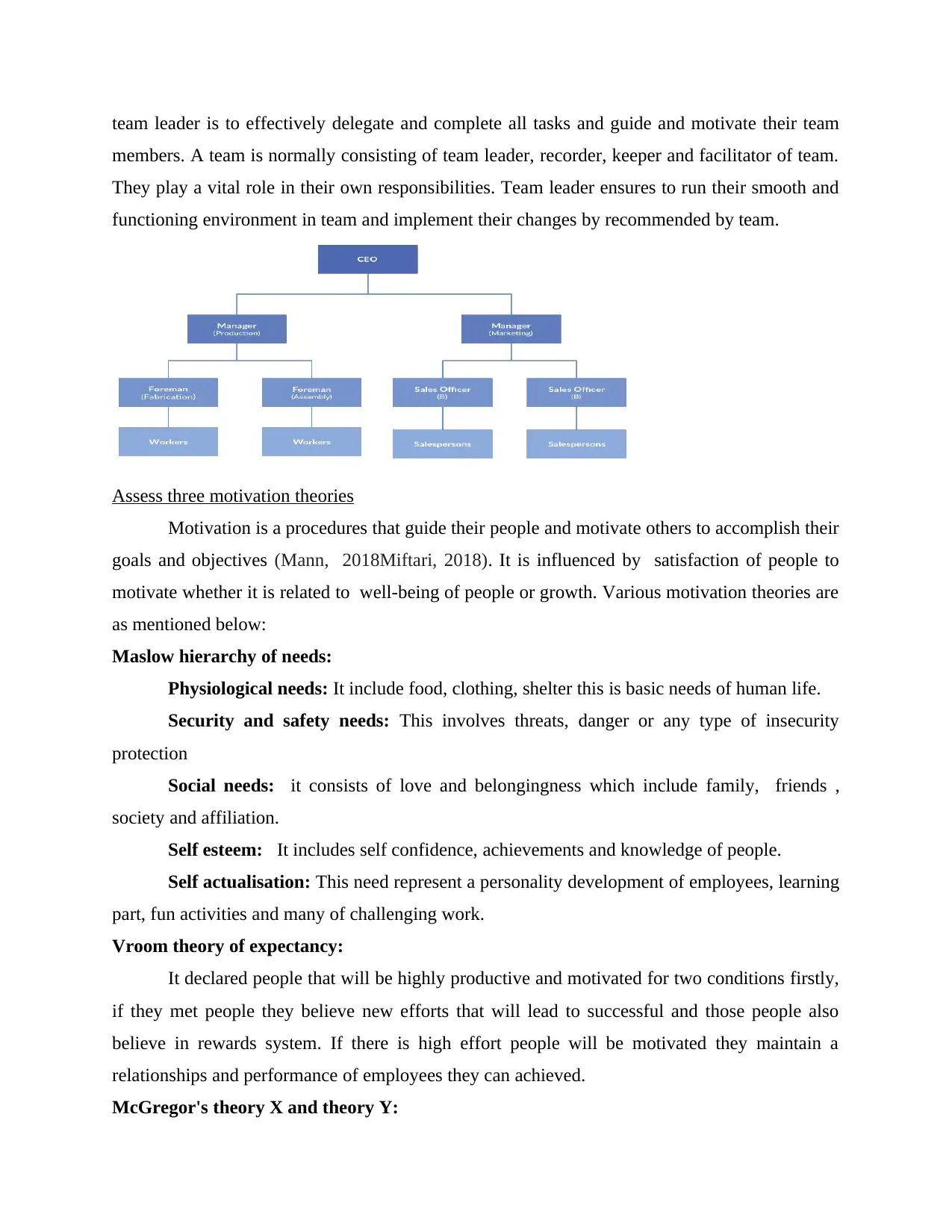
team leader is to effectively delegate and complete all tasks and guide and motivate their team
members. A team is normally consisting of team leader, recorder, keeper and facilitator of team.
They play a vital role in their own responsibilities. Team leader ensures to run their smooth and
functioning environment in team and implement their changes by recommended by team.
Assess three motivation theories
Motivation is a procedures that guide their people and motivate others to accomplish their
goals and objectives (Mann, 2018Miftari, 2018). It is influenced by satisfaction of people to
motivate whether it is related to well-being of people or growth. Various motivation theories are
as mentioned below:
Maslow hierarchy of needs:
Physiological needs: It include food, clothing, shelter this is basic needs of human life.
Security and safety needs: This involves threats, danger or any type of insecurity
protection
Social needs: it consists of love and belongingness which include family, friends ,
society and affiliation.
Self esteem: It includes self confidence, achievements and knowledge of people.
Self actualisation: This need represent a personality development of employees, learning
part, fun activities and many of challenging work.
Vroom theory of expectancy:
It declared people that will be highly productive and motivated for two conditions firstly,
if they met people they believe new efforts that will lead to successful and those people also
believe in rewards system. If there is high effort people will be motivated they maintain a
relationships and performance of employees they can achieved.
McGregor's theory X and theory Y:
members. A team is normally consisting of team leader, recorder, keeper and facilitator of team.
They play a vital role in their own responsibilities. Team leader ensures to run their smooth and
functioning environment in team and implement their changes by recommended by team.
Assess three motivation theories
Motivation is a procedures that guide their people and motivate others to accomplish their
goals and objectives (Mann, 2018Miftari, 2018). It is influenced by satisfaction of people to
motivate whether it is related to well-being of people or growth. Various motivation theories are
as mentioned below:
Maslow hierarchy of needs:
Physiological needs: It include food, clothing, shelter this is basic needs of human life.
Security and safety needs: This involves threats, danger or any type of insecurity
protection
Social needs: it consists of love and belongingness which include family, friends ,
society and affiliation.
Self esteem: It includes self confidence, achievements and knowledge of people.
Self actualisation: This need represent a personality development of employees, learning
part, fun activities and many of challenging work.
Vroom theory of expectancy:
It declared people that will be highly productive and motivated for two conditions firstly,
if they met people they believe new efforts that will lead to successful and those people also
believe in rewards system. If there is high effort people will be motivated they maintain a
relationships and performance of employees they can achieved.
McGregor's theory X and theory Y:
Paraphrase This Document
Need a fresh take? Get an instant paraphrase of this document with our AI Paraphraser
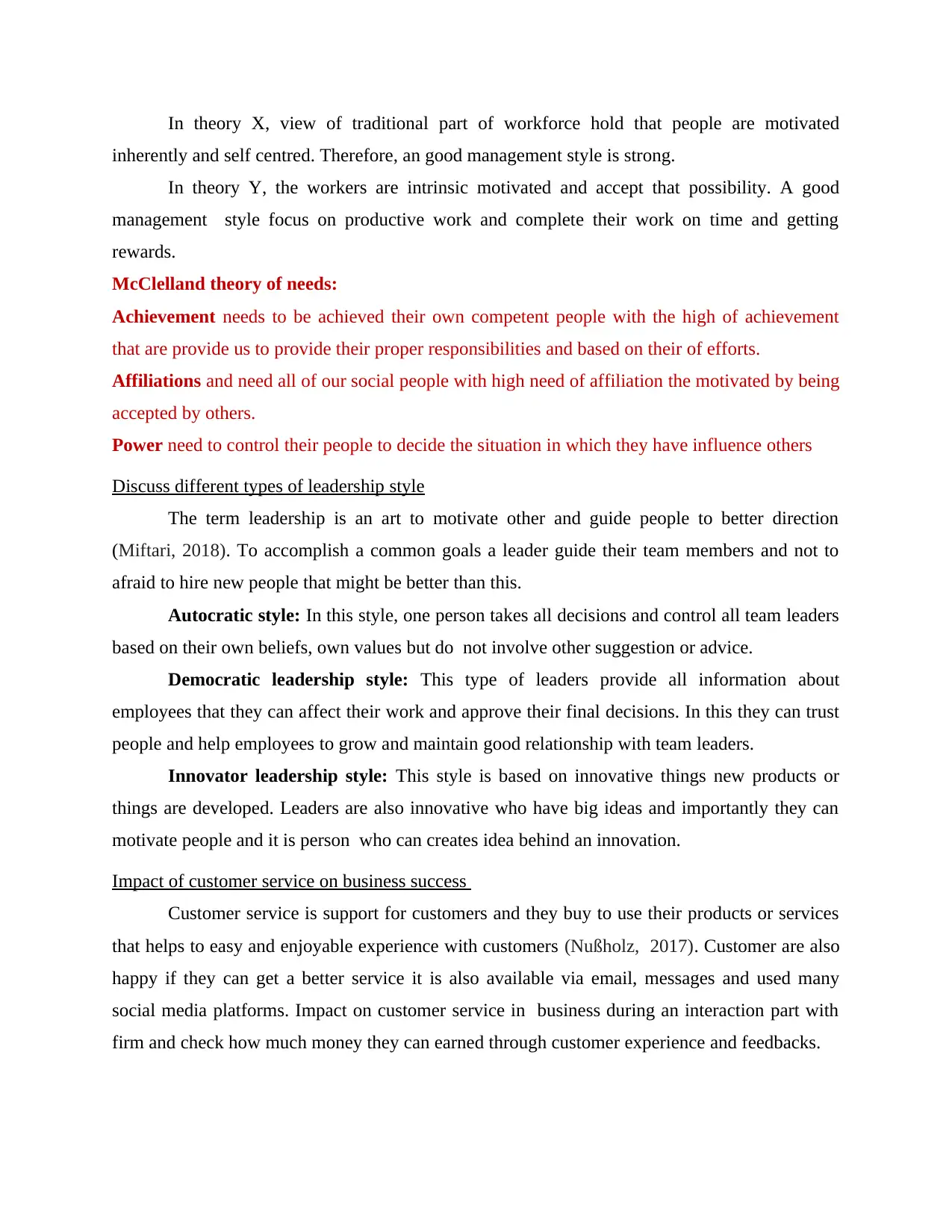
In theory X, view of traditional part of workforce hold that people are motivated
inherently and self centred. Therefore, an good management style is strong.
In theory Y, the workers are intrinsic motivated and accept that possibility. A good
management style focus on productive work and complete their work on time and getting
rewards.
McClelland theory of needs:
Achievement needs to be achieved their own competent people with the high of achievement
that are provide us to provide their proper responsibilities and based on their of efforts.
Affiliations and need all of our social people with high need of affiliation the motivated by being
accepted by others.
Power need to control their people to decide the situation in which they have influence others
Discuss different types of leadership style
The term leadership is an art to motivate other and guide people to better direction
(Miftari, 2018). To accomplish a common goals a leader guide their team members and not to
afraid to hire new people that might be better than this.
Autocratic style: In this style, one person takes all decisions and control all team leaders
based on their own beliefs, own values but do not involve other suggestion or advice.
Democratic leadership style: This type of leaders provide all information about
employees that they can affect their work and approve their final decisions. In this they can trust
people and help employees to grow and maintain good relationship with team leaders.
Innovator leadership style: This style is based on innovative things new products or
things are developed. Leaders are also innovative who have big ideas and importantly they can
motivate people and it is person who can creates idea behind an innovation.
Impact of customer service on business success
Customer service is support for customers and they buy to use their products or services
that helps to easy and enjoyable experience with customers (Nußholz, 2017). Customer are also
happy if they can get a better service it is also available via email, messages and used many
social media platforms. Impact on customer service in business during an interaction part with
firm and check how much money they can earned through customer experience and feedbacks.
inherently and self centred. Therefore, an good management style is strong.
In theory Y, the workers are intrinsic motivated and accept that possibility. A good
management style focus on productive work and complete their work on time and getting
rewards.
McClelland theory of needs:
Achievement needs to be achieved their own competent people with the high of achievement
that are provide us to provide their proper responsibilities and based on their of efforts.
Affiliations and need all of our social people with high need of affiliation the motivated by being
accepted by others.
Power need to control their people to decide the situation in which they have influence others
Discuss different types of leadership style
The term leadership is an art to motivate other and guide people to better direction
(Miftari, 2018). To accomplish a common goals a leader guide their team members and not to
afraid to hire new people that might be better than this.
Autocratic style: In this style, one person takes all decisions and control all team leaders
based on their own beliefs, own values but do not involve other suggestion or advice.
Democratic leadership style: This type of leaders provide all information about
employees that they can affect their work and approve their final decisions. In this they can trust
people and help employees to grow and maintain good relationship with team leaders.
Innovator leadership style: This style is based on innovative things new products or
things are developed. Leaders are also innovative who have big ideas and importantly they can
motivate people and it is person who can creates idea behind an innovation.
Impact of customer service on business success
Customer service is support for customers and they buy to use their products or services
that helps to easy and enjoyable experience with customers (Nußholz, 2017). Customer are also
happy if they can get a better service it is also available via email, messages and used many
social media platforms. Impact on customer service in business during an interaction part with
firm and check how much money they can earned through customer experience and feedbacks.
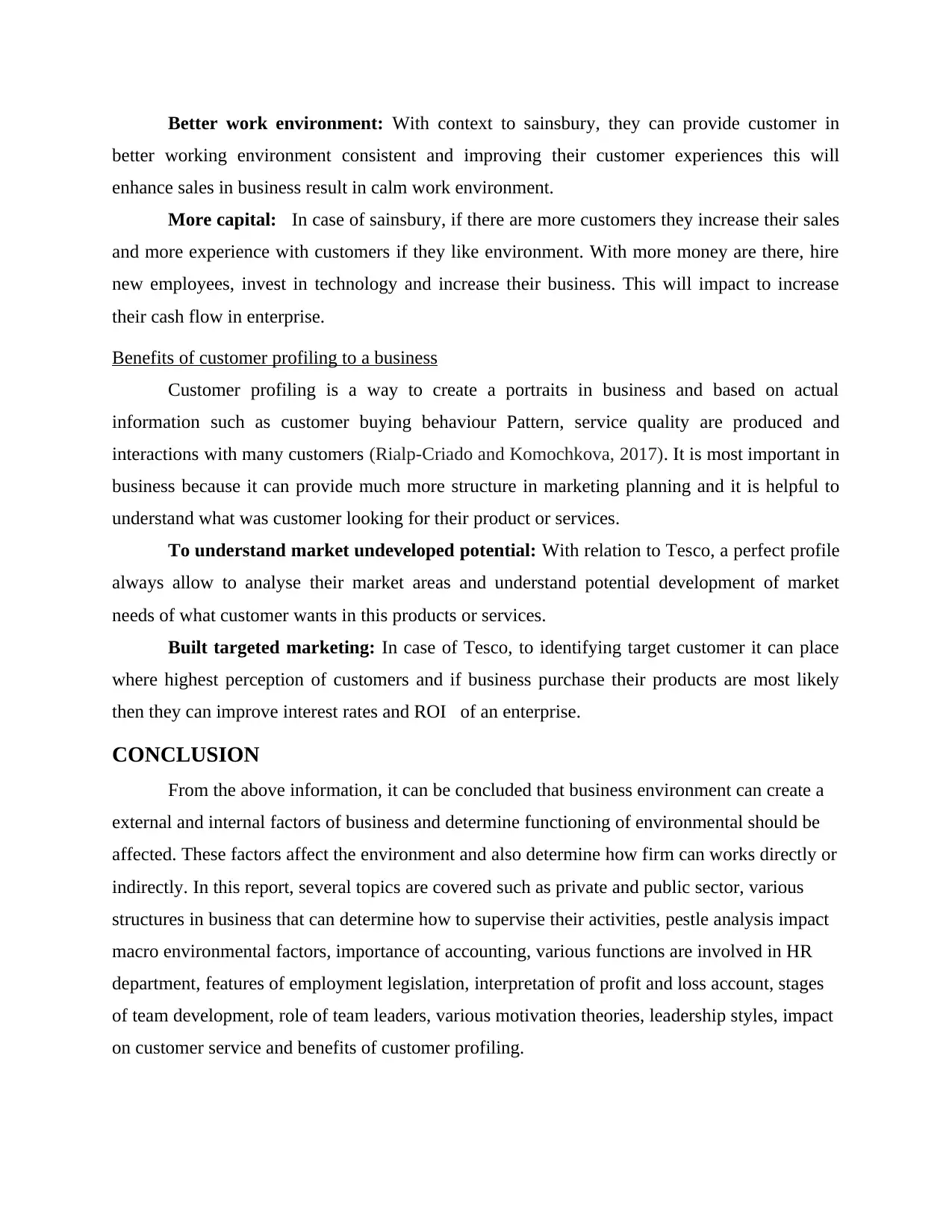
Better work environment: With context to sainsbury, they can provide customer in
better working environment consistent and improving their customer experiences this will
enhance sales in business result in calm work environment.
More capital: In case of sainsbury, if there are more customers they increase their sales
and more experience with customers if they like environment. With more money are there, hire
new employees, invest in technology and increase their business. This will impact to increase
their cash flow in enterprise.
Benefits of customer profiling to a business
Customer profiling is a way to create a portraits in business and based on actual
information such as customer buying behaviour Pattern, service quality are produced and
interactions with many customers (Rialp-Criado and Komochkova, 2017). It is most important in
business because it can provide much more structure in marketing planning and it is helpful to
understand what was customer looking for their product or services.
To understand market undeveloped potential: With relation to Tesco, a perfect profile
always allow to analyse their market areas and understand potential development of market
needs of what customer wants in this products or services.
Built targeted marketing: In case of Tesco, to identifying target customer it can place
where highest perception of customers and if business purchase their products are most likely
then they can improve interest rates and ROI of an enterprise.
CONCLUSION
From the above information, it can be concluded that business environment can create a
external and internal factors of business and determine functioning of environmental should be
affected. These factors affect the environment and also determine how firm can works directly or
indirectly. In this report, several topics are covered such as private and public sector, various
structures in business that can determine how to supervise their activities, pestle analysis impact
macro environmental factors, importance of accounting, various functions are involved in HR
department, features of employment legislation, interpretation of profit and loss account, stages
of team development, role of team leaders, various motivation theories, leadership styles, impact
on customer service and benefits of customer profiling.
better working environment consistent and improving their customer experiences this will
enhance sales in business result in calm work environment.
More capital: In case of sainsbury, if there are more customers they increase their sales
and more experience with customers if they like environment. With more money are there, hire
new employees, invest in technology and increase their business. This will impact to increase
their cash flow in enterprise.
Benefits of customer profiling to a business
Customer profiling is a way to create a portraits in business and based on actual
information such as customer buying behaviour Pattern, service quality are produced and
interactions with many customers (Rialp-Criado and Komochkova, 2017). It is most important in
business because it can provide much more structure in marketing planning and it is helpful to
understand what was customer looking for their product or services.
To understand market undeveloped potential: With relation to Tesco, a perfect profile
always allow to analyse their market areas and understand potential development of market
needs of what customer wants in this products or services.
Built targeted marketing: In case of Tesco, to identifying target customer it can place
where highest perception of customers and if business purchase their products are most likely
then they can improve interest rates and ROI of an enterprise.
CONCLUSION
From the above information, it can be concluded that business environment can create a
external and internal factors of business and determine functioning of environmental should be
affected. These factors affect the environment and also determine how firm can works directly or
indirectly. In this report, several topics are covered such as private and public sector, various
structures in business that can determine how to supervise their activities, pestle analysis impact
macro environmental factors, importance of accounting, various functions are involved in HR
department, features of employment legislation, interpretation of profit and loss account, stages
of team development, role of team leaders, various motivation theories, leadership styles, impact
on customer service and benefits of customer profiling.
⊘ This is a preview!⊘
Do you want full access?
Subscribe today to unlock all pages.

Trusted by 1+ million students worldwide
1 out of 14
Related Documents
Your All-in-One AI-Powered Toolkit for Academic Success.
+13062052269
info@desklib.com
Available 24*7 on WhatsApp / Email
![[object Object]](/_next/static/media/star-bottom.7253800d.svg)
Unlock your academic potential
Copyright © 2020–2025 A2Z Services. All Rights Reserved. Developed and managed by ZUCOL.




